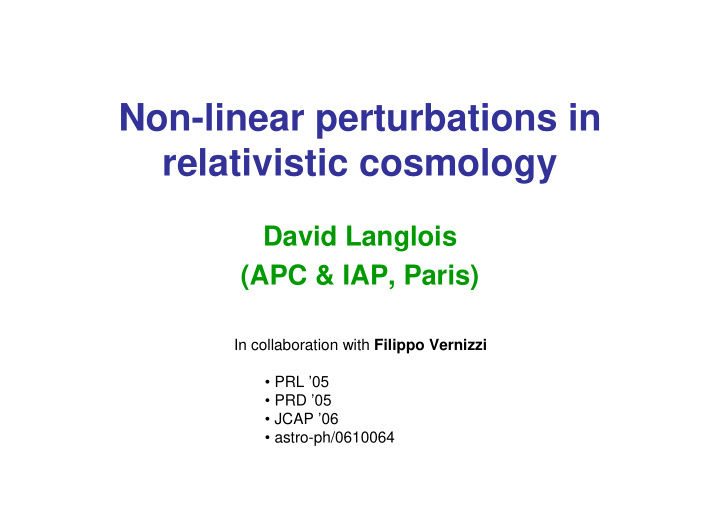



Non-linear perturbations in relativistic cosmology David Langlois (APC & IAP, Paris) In collaboration with Filippo Vernizzi • PRL ’05 • PRD ’05 • JCAP ’06 • astro-ph/0610064
Motivations • Linear theory of relativistic cosmological perturbations extremely useful • Non-linear aspects are needed in some cases: – non-gaussianities – Universe on very large scales (beyond the Hubble scales) – small scales • Conservation laws – solve part of the equations of motion – useful to relate early universe and ``late cosmology’’ Early Universe geometry
Linear theory • Perturbed metric (with only scalar perturbations) • related to the intrinsic curvature of constant time spatial hypersurfaces • Change of coordinates, e.g.
Linear theory • Curvature perturbation on uniform energy density hypersurfaces [Bardeen et al (1983)] gauge-invariant • The time component of yields [Wands et al (2000)] For adiabatic perturbations, conserved on large scales
Covariant formalism [ Ellis & Bruni (1989) ] • How to define unambiguously • One needs a map If is such that , then • Idea: instead of , use its spatial gradient
• Perfect fluid: • Spatial projection: • Expansion: • Integrated expansion : Local scale factor • Spatially projected gradients :
New approach [ DL & Vernizzi, PRL ’05; PRD ’05 ] • Define • Projection of along yields • Spatial gradient
• One finally gets • This is an exact equation, fully non-linear and valid at all scales ! • It “mimics” the linear equation
Comparison with the coordinate based approach • Choose a coordinate system • Expand quantities: • First order Usual linear equation !
• Second order perturbations After some manipulations, one finds in agreement with previous results [ Malik & Wands ’04]
Gauge-invariance • Second-order coordinate transformation Bruni et al. ‘97 ζ a is gauge-invariant at 1 st order but not 2 nd order • • But, on large scales, and is gauge-invariant on large scales!
Cosmological scalar fields: single and multi-field inflation • Multi-field inflation – Generated fluctuations can be richer (adiabatic and isocurvature) – Adiabatic and isocurvature perturbations can be correlated (D.L. ’99) – Decomposition into adiabatic & isocurvature modes (Gordon et al. ‘01) E.g. for two fields φ and χ , one can write From Gordon et al. ‘01
Cosmological scalar fields: covariant approach • Several (minimally coupled) scalar fields • Equation of motion • Energy-momentum tensor
Two scalar fields • Adiabatic and entropy directions with • Adiabatic and entropy covectors
Equations of motion • “Homogeneous-like” equations • FLRW equations
“Linear-like” equations 1. Evolution of the adiabatic covector 2. Evolution of the entropy covector
Linearized equations • First order spatial components of and Second order equations for δσ and δ s • One usually replaces δσ by the gauge-invariant quantity
Linearized equations [Gordon et al. ’01] • Adiabatic equation • Entropy equation • On large scales,
Second order perturbations • Entropy perturbation • Adiabatic perturbation
Large scale evolution • Alternative adiabatic variable • Using the 2nd order energy and moment constraints,
Large scale evolution • The entropy evolution on large scales is given by • Evolution for ζ (2) • Non-local term
Conclusions • New approach to study cosmological perturbations – Non linear – Purely geometric formulation (extension of the covariant formalism) – ``Mimics’’ the linear theory equations – Get easily the second order results – Exact equations: no approximation • Can be extended to scalar fields – Covariant and fully non-linear generalizations of the adiabatic and entropy components – Evolution, on large scales, of the 2 nd order adiabatic and entropy components
Recommend
More recommend